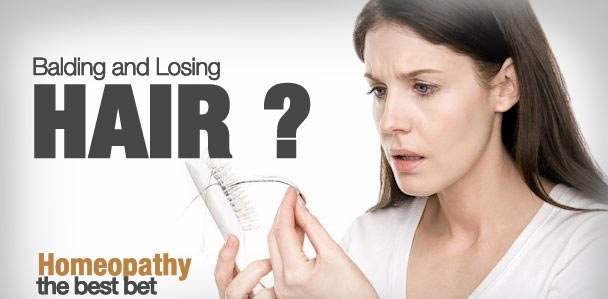
Balding and Losing Hair ? …Homeopathy the Best Bet
We all have some emotional relationship with our hair. Whether we wear it long or short, a certain amount of time every day goes into grooming the hair. It is through the course of this everyday habit that people first notice hair fall and other changes in
the scalp and hair. Thinning hair is often worrisome since its the first step (among many) that can lead to permanent hair loss and eventual baldness. Homeopathy for hair fall includes treatments that help prevent hair fall, and also maintain the quality of hair still growing.
For example, Lycopodium is a homeopathic medicine for hair fall that gives excellent results. It helps in hair growth and works very well in cases of male pattern balding. Hair regrowth with homeopathy works well when the underlying causes of hair fall have been correctly identified. Once the hair cycle falls into place, and the growth stage normalizes, hair fall ceases to be a problem. The best homeopathic medicine for hair growth is chosen according to the symptoms and pattern of the hair fall.
The thing about hair fall is, it happens everyday! An average adult head would have about 100,000 to 150,000 hairs. Out of these, it is normal to lose about 50 to 100 strands of hair every day. The problem of hair loss and thinning begins when the cycle of hair growth does not keep pace with the cycle of hair loss. As long as the hair continues to regrow at the same speed as it falls (naturally), hair loss is not an issue.
In order to understand the causes of hair loss and thinning of hair, it is important to look into the life cycle of hair.
The many stages of hair
Normal phases of hair growth: There are different phases of hair growth including anagen, catagen and telogen phase. After completion of the last stage, the entire cycle is repeated. Every single hair undergoes these three phases of growth independent of the other hair on the scalp.
Anagen phase (growth phase) – It lasts for 3 to 5 yrs. This is the active phase where hair root divides at a high pace and results in hair growth. At a given time around 85% of hairs are in this phase.
Catagen (regression phase) – Around 1- 3 % of the hair are in this phase at a given time. Approximately last 10 – 20 days where the hair stops growing.
Telogen phase (resting/shedding phase) – At a given time approximately 10% of the hair are in this phase. It lasts mostly around three months, after which the hair falls out.
In case of male pattern baldness the anagen phase i.e. the growth phase is shortened, while the duration of the shedding phase remains the same. As a result, less hair grows at a given time in this short time span (as compared to normal hair growth) while more hair continues to shed at the same time.
There are many factors that can lead to hair fall – they can be genetic, or be related to health issues. The most common types of hair loss, along with the suitable homeopathic treatments, are identified here in the following sequence:
A. What is Male Pattern Balding
B. What is Female Pattern Balding
C. General Factors
D. Scalp Diseases that lead to Hair Loss
A. What is Male Pattern Baldness?
Male balding is a surprisingly common problem, and yet men tend to feel isolated when suffering through it. According to statistics, 40% of the men undergo noticeable hair loss by the age of 35. By the time they’re 80, they would have lost almost 80% of their hair. Homeopathy for hair loss works by strengthening the hair follicle and moderating the effects of the hormones associated with hair loss.
In young males, male pattern baldness typically begins from the frontal area and the crown. With age, it progresses towards the back of the head.
Anybody with a genetic predisposition towards baldness typically experiences a change in the hair-growth cycle, mostly caused due to the action of the hormone dihydrotestosterone. The hair falls out naturally, but the new hair that is supposed to grow is thinner, shorter and has a lighter pigmentation. This means that although the hair continues to grow from the root, it is too thin to be sustained. The rate of new hair growing out as compared to the rate with which it falls is the main sign of male pattern baldness.
Are you heading towards early hair loss?
With the given statistics, it is a fact that every other male will suffer early hair loss and male balding. Signs of early hair loss in men can be visible as early as the age of 18. Some common early warning signs of male pattern baldness include:
- receding hairline from the forehead and temples
- bald patch on top of the scalp
- reduced density of hair
- thinning of hair
- itching on the scalp
What are the main reasons for Male Pattern Baldness?
Changing Hormone Levels (Androgens)
Male pattern baldness is linked with male sex hormones or androgens including testosterone and dihydrotestosterone. Androgens help in the development of male sex organs and other male characteristics including deepening of the voice, increasing muscle/bone mass, sperm production, controlling sex drive and growth of body hair including facial hair growth. The change in levels of these hormones results in shrinking of hair follicles and shortening of the growth phase of hair (anagen phase). These two factors result in hair loss.
Shrinking of Hair Follicles
Hair follicles are a pouch or sac found under the skin, from which a hair grows. A person on an average has 1,50000 hair follicles on the scalp. In case of male pattern baldness due to shrinking of hair follicles either short, thin hair grows, or a stage where no hair grows at all is reached.
Shortening of the growth phase of hair (anagen phase)
The Pattern of Hair Loss in Men
Hair fall in men usually follows any one of the two patterns:
Receding: It is a very common condition where the hairline starts receding from the forehead, or the front of the head and the sides, along the temples. The hair gradually starts thinning out, giving the illusion of a larger forehead.
Vertex Thinning: The hair all over the head, and mainly around the crown starts thinning out. New hair grows, but thinly.
So what are the factors that contribute to this steady loss of hair?
Male pattern balding is the result of many inter-dependent factors. They can be hereditary or be associated with lifestyle choices. In some cases, underlying health conditions can indirectly cause hair loss.
You get it from your mother … True or False?
It is common knowledge that male pattern baldness is inherited from the mother. This is true because the baldness gene is present on the X chromosome (the female chromosome), so it is the woman who passes it on. This hereditary factor is dominant on the maternal side, which means that even if the father has a head full of hair, the son may experience male pattern baldness at a young age. This is especially so if the mother’s brother has a receding hairline.
However, the male pattern baldness gene gets passed down from both sides of the family and it may skip generations. Even within the same generation, one male child may have thick hair while the other may suffer from a receding hairline.
It runs in the family.
Numerous studies have proved that the degree of relationship in terms of family history also increases the severity of baldness. For example, a person whose father or sibling (first-degree relative) experiences baldness is more likely to undergo moderate-to-severe baldness himself as compared to someone who had more distant relatives experiencing baldness. The former are 13 times more likely to have baldness as compared to those with no family history.
Could you be smoking your hair away?
According to a research, the prevalence of baldness increases with age. In terms of smoking, a comparison between people who had ‘never smoked’ and the ones who were current smokers or had quit, gave interesting results. Current smokers, or those who had quit, were almost twice as likely to experience moderate to severe hair loss. Further, a comparison between current smokers (who smoked less than 20 cigarettes a day) and those who smoked but had quit, were not at an increased risk of baldness.
The intensity of smoking, therefore, is also related to the likelihood of baldness.
Smoking has adverse effects on many systems within the body. It leads to poor circulation of oxygen and essential nutrients through the blood, which leads to reduced hair and scalp health. Also, chemicals found in tobacco are toxic and can damage the hair follicles.
Drinking is no better …
Male pattern baldness and the consumption of alcohol are closely linked factors. The main reasons why alcohol harms the body and aggravates baldness are:
- Alcohol leads to the consumption of empty calories. The person drinking alcohol may feel too full to eat a proper, nutritious meal. This leads to a lack of nutrition in the body, which can aggravate baldness.
- Lack of a well-balanced diet can lead to the deficiency of vitamins like B1 (thiamine), which is essential for hair growth.
- Alcohol also contributes to hair loss by damaging the stomach lining as well as the liver, which leads to an increase in the production of acid in the digestive system. This makes it difficult for the body to absorb nutrients properly.
Excessive drinking leads to a diuretic effect due to which the levels of magnesium and potassium in the body can drop. The body is then unable to sustain healthy functions, including hair growth.
The only time alcohol is helps the hair is when we drench the hair with beer during a wash. Keeping the hair drenched in beer for a minute or so before rinsing it out helps strengthen the hair.
Steroids: What works on the body might not be working on your hair
Anabolic steroids are a group of synthetic and natural steroid hormones that are used to promote muscle strength and growth. Testosterone, for example, is a natural anabolic steroid.
The relation between steroids and hairloss is linked through hormones. The hormone dihydrotestosterone (DHT) is one of the primary hormones linked to male pattern baldness. Steroids accelerate the production of DHT. When the amount of DHT increases in the system, it leads to hair loss. It should be noted that balding due to the use of an anabolic steroid happens if a male is already genetically predisposed towards balding. Steroids only speed up the process.
The hormone DHT binds to the receptors in the hair follicles, causing them to shrink, weaken and die (a process known as miniaturization). In contrast, DHT acts as an essential hormone that is responsible for hair growth in other areas of the body, like the back and chest.
It can thus be concluded that men who do not have a genetic predisposition towards hair loss may not go bald by using steroids but can experience a milder form of hair loss. Topical treatment with DHT blockers for hair loss is often used in such cases.
Prostate Related Issues
As the second most common type of cancer in males, prostate cancer is a leading cause of male pattern baldness. The link here is the hormone Dihydrotestosterone (DHT), which is made from testosterone by an enzyme called 5-alpha reductase. This hormone is present in the hair follicles, skin and the prostate. The sensitivity of the hair follicles to this hormone is the main cause of hair loss. Although they are separate conditions, male pattern baldness and prostate cancer are linked by the DHT hormone. DHT stimulates the growth of prostate cells, contributing to benign prostatic hyperplasia (BPH) or prostate cancer in older men. With age, the DHT levels rise, and an accumulation of this hormone leads to an enlarged prostate.
Testosterone and prostate enlargement, male pattern baldness, and prostate cancer are all hormone-dependent. Androgenetic alopecia treatment in homeopathy involves moderating the effect of these hormones.
Homeopathic remedy for baldness is a more conservative form of treatment as compared to conventional treatments. Conventional treatment involves the use of drugs like minoxidil and finasteride and other methods like a hair transplant.
Minoxidil works by stimulating the hair follicles and is said to help grow new hair, but it can have side effects like unwanted body hair, irregular heartbeat, allergic drug reactions like a rash, swelling of the throat, face, or tongue and dizziness.
Finasteride is a drug used to treat inflammation in the prostate glands by reducing the production of DTH, which also helps decrease the rate of hair loss. Its side effects include allergic reactions like hives, swelling on the face and difficulty in breathing. Impotence and loss of interest in sexual activity are some more severe side effects. These (if developed) tend to continue even after stopping the medicine.
Is homeopathic treatment effective in men? Homeopathic treatment for hair loss works by targeting the root cause – whether it is a hormonal problem or a disease. There are no side effects of homeopathic medicines for male balding, which makes them an effective option.
Top Three Homeopathic Medicines for Male Pattern Baldness
Lycopodium Clavatum – Top Homeopathic Medicine for Hair Regrowth
Lycopodium Clavatum is a natural homeopathic medicine for treating male pattern baldness. It is prepared from a plant named club moss. This plant is of natural order Lycopodiaceae.
This is a homeopathic medicine for fast hair regrowth in male pattern baldness. In most cases, there is hair loss from the sides of the scalp (temple region). Along with that, dandruff may be present with a bad smell from the scalp. The scalp may be itchy and a burning sensation can also be present.
Baryta Carb – Homeopathic Medicine for Male Pattern Baldness with Hair Loss from Top of Scalp
Baryta Carb is a homeopathic medicine used for male pattern baldness where hair loss is mostly visible on the crown or top of the scalp (vertex). The scalp may be sensitive to touch, along with a crawling sensation.
Silicea – Homeopathic Medicine for Male Pattern Baldness in Young Males
Silicea is useful homeopathic medicines for male pattern baldness in very young males, where the males tend to experience hair loss very early in their life. Severe itching and prickling of the scalp, excessive sweating on the scalp (that smells sour and offensive) is also present. Another important feature is the sensation of coldness felt on the scalp.
Managing Male Pattern Baldness
Managing male pattern baldness requires a preventative approach. If you’re wondering whether male pattern balding is reversible or not, the answer is – it depends. It depends on the underlying cause of hair fall that can be treated with the help of homeopathy.
However, hair loss can be slowed down without using any drastic methods. Some of these include:
Washing hair with gentle movements and lukewarm water, and drying them carefully to maintain the remaining hair.
Getting an adequate amount of sleep and reducing stress is essential since the concentration of growth hormones in the body is the highest during sleep.
Embracing hair loss as a part of genetics, aging and life, in general, can help escape the stigma that surrounds the problem. It is a natural part of life and should be embraced as is. Examples of male pattern balding are plentiful, and many celebrities are living proof that this is nature’s way of life.
Reversing male pattern baldness is subject to individual factors. Generalized treatments may work on some people, while others see no concrete or long-lasting results. Hair transplants are becoming an increasingly common method of managing baldness and works as a good alternative in severe cases.
B. What is Female Pattern Baldness?
Also known as androgenetic alopecia, female pattern baldness is very similar to male pattern baldness. The main difference between male and female pattern baldness is the pattern of hair loss. In females, thinning of hair (and not a receding hairline) is observed. Women carry a very little chance of going completely bald as compared to males. However, 40% of the women experience visible hair loss by the time they touch the age of 40 years. Thinning of hair begins between the age of 25 to 35 years. 90% of female baldness is directly linked to genetics, although there are other contributing factors. Since many factors can cause hair fall in women, it is difficult to diagnose, and treat the exact problem.
Female hair loss treatment with homeopathy offers a conservative course of medicines that work gradually over time to fix the problem from the root. Conventional treatment includes the use of drugs like minoxidil and androgen-blockers, but unless the root cause of the hair fall is identified, these treatments only act as placebos.
Are you heading towards female pattern baldness?
The early key indication to recognize female pattern baldness is the gradual loss of hair from the parting line of the hair on the scalp. Found around the area of the center of the scalp, most females begin losing hair from their parting line. This progresses to the widening of the parting line, followed by general diffused hair thinning on the scalp. There are very little chances of complete baldness, but excessive thinning of hair throughout the scalp is generally observed.
Female pattern baldness can be divided into three grades. In the first grade, there is slight thinning of hair around the part line. In the second grade, the parting line gets widened with increased thinning of hair around it. In the third grade, there is diffused hair thinning throughout the scalp. Spots of the scalp may also be visible in this case.
What causes Female Pattern Baldness?
In females, the leading cause of baldness is the shrinking of the hair follicles. This shrinking leads to the production of short and thin hair, along with a shortening of the hair growth phase.
No specific cause has been determined as yet, although the androgens (hormones) are thought to play a role.
In rare cases, tumors (benign, non-cancerous) of the pituitary gland or ovaries or adrenals that secrete androgens also can lead to female pattern hair loss.
The major contributing factor towards female pattern baldness is a genetic predisposition (history of hair loss on either side of the family). It’s more commonly seen in middle-aged women and after menopause.
Female pattern baldness in the 20s is usually related to heredity, lifestyle or stress.
Homeopathic Medicines for Hair Fall in Females
Sepia Succus – Top Homeopathic Medicine for Female Pattern Baldness
Sepia Succus is a homeopathic medicine used to treat female pattern baldness and hair fall. A common symptom for this medicine is a history of long-standing headaches. In menopausal age, Sepia Succus has been successfully used to treat female pattern baldness. The women may complain of hot flushes followed by chills and perspiration. Bearing down pains in the uterus at menopause along with hair loss may be present. Some mental symptoms that point towards this medicine include irritability and indifferent behavior towards family members.
Natrum Mur – Homeopathic Medicine for Hair Loss in Women
Natrum Mur is a homeopathic medicine for hair fall in women who lose hair on the slightest touch. They may also be anemic. This medicine is usually prescribed to women experiencing hair loss after childbirth. Along with hair loss, severe headache after the delivery of a child may be present. The headache tends to get worse in the heat of the sun, and there may be inordinate craving for salty things.
Managing Female Pattern Balding
Any treatment that focusses on female pattern balding is usually aimed towards slowing down the rate of hair loss. Seldom do these treatments focus on promoting hair regrowth.
The biggest issue with hair loss in females is that of self-confidence. A new hairstyle, or using scarves and wigs is one way to deal with a very natural condition. Apart from using homeopathic treatment for hair fall, accepting the problem as a part of life is a good way forward.
C. Hair fall from Scalp Conditions
Many scalp conditions can lead to or contribute towards hair loss. Some of the major scalp conditions associated with hair fall include tinea capitis, lichen planus, eczema of the scalp (seborrheic dermatitis), scalp folliculitis and dandruff.
Fungal Infection of Scalp (Tinea Capitis)
Tinea capitis is a contagious infection of the scalp. It spreads from person to person contact or by sharing objects like towels, combs, hair brushes. Its main features are itchy, scaly patches on the scalp. These patches tend to enlarge gradually. Blisters may also appear with oozing of fluid. The hair in the affected area gets brittle, and they break off. So, bald patches on the scalp tend to come on.
Lichen Planus
Lichen planus is an autoimmune condition affecting skin, hair and mucous membranes. It leads to flat-topped purple colored papules on the skin. In cases where lichen planus involves scalp discoloration, hair loss is also noted.
Eczema of the Scalp (Seborrheic dermatitis)
Eczema of the scalp is known as seborrheic dermatitis. It is an oily, inflammatory condition along with flakiness/dandruff that mainly affects the scalp. Itching and burning of varying degrees may appear. The flakes tend to clog the hair follicles and hinder hair growth. The hair may stick to the oily flakes and tend to fall off on scratching. Hair loss, therefore, becomes an associated condition with seborrheic dermatitis. Apart from the scalp, other areas like the face, eyelashes, ears, and chest also get affected.
Scalp folliculitis
Inflammation and infection of hair follicles of the scalp are termed as scalp folliculitis. It may be a result of a bacterial infection, fungal infection or due to overproduction of sebum that clogs the hair follicles on the scalp. The features of scalp folliculitis include pimples or pustular eruptions on the scalp. There may be yellowish or clear fluid oozing from these eruptions. Itching, burning, and pain attends is accompanied by hair loss.
Dandruff
Dandruff is a scalp condition wherein with flakiness on the scalp is present along with itching. Dandruff does not cause hair fall directly, but the itching and the attended scratching of the scalp lead to hair fall.
Homeopathic Medicine for Hair Loss from Scalp Conditions
Graphites Naturalis – Homeopathic Medicine for Hair Loss from Fungal Infection (tinea capitis)
Graphites Naturalis is a homeopathic medicine for hair loss that occurs as a result of a fungal infection of the scalp. Scaly, itchy spots on the scalp appear, accompanied by hair fall. Intolerable itching on the scalp, soreness on the scalp as well as a burning sensation may be present.
Arsenic Album – Homeopathic Medicine for Hair Fall from Lichen Planus
Arsenic Album is a homeopathic medicine for hair fall that occurs as a result of the autoimmune disease lichen planus. Rough, bald patches on the scalp may appear, along with itching and burning. The scalp may also be sensitive to touch.
Kali Sulph – Homeopathic Medicine for Hair Fall from Seborrheic Dermatitis
Kali Sulph is a homeopathic medicine for hair fall that occurs due to seborrheic dermatitis. The dandruff flakes are yellow in color, very moist, and sticky. The scalp may be itchy and this gets worse in warm conditions.
Mezereum – Homeopathic Medicine for Hair Fall due to Folliculitis
Mezereum is a homeopathic medicine for hair loss in cases where the hair gets destroyed due to folliculitis of the scalp. Symptoms like thick crusty eruptions on the scalp, a discharge of thick offensive pus, matting of hair, breeding of germs, and the gradual eating away of the hair due to discharges lead to hair loss.
Thuja Occidentalis – Homeopathic Medicine for Hair Fall and Dandruff
Thuja Occidentalis is a homeopathic medicine for hair fall and dandruff. This medicine is prepared from the plant named Arborvitae, of the coniferae order. This medicine is used to treat cases where the dandruff is white, hair is dry with split ends and falls out easily. It helps treat dandruff as well as associated hair fall.
D. General Causes of Hair Fall
Hairfall can also be a result of some health issues that are common in everyday life. Emotional or mental stress, change of environment, the quality of bathing water and diet in general can contribute towards hair fall.
Thyroid – thyroid problems cause hair loss in severe and prolonged cases. Since thyroid and alopecia areata are both autoimmune diseases, one can trigger the other. Hair fall due to thyroid can be treated once the underlying hormonal imbalance is fixed, although it can take some time for the hair to grow back.
Hormonal changes including those that occur after childbirth, during menopause, hypothyroidism, PCOS.
Recovery from acute fevers like typhoid and erysipelas leads to diffused hair loss.
Emotional trauma like constant stress or grief due to loss of a family member/close friend.
Alopecia Areata is an autoimmune disease that causes hair loss. In this condition, the immune cells of the body mistake the hair cells as a foreign body and start destroying them. The associated hair loss occurs in patches/spots. It is a common cause of hair fall in people under 20 years of age and is commonly found in people with autoimmune thyroid problems.
Drugs (like the ones used to treat high blood pressure, joint pains, cancer, or depression) can also cause hair fall as a side effect. For example, anagen effluvium refers to a condition of hair loss due to chemotherapy in a cancer patient. Chemotherapy drugs used as a part of cancer treatment damage hair follicles, leading to hair loss.
Physical trauma/injury to the head can also lead to hair fall in some cases.
General diseases like diabetes mellitus, tuberculosis, or AIDS tend to cause hair fall due to decreased immunity and nutrition in the body.
Certain hairstyles like tight braids or ponytails where the hair is tightly pulled back can lead to traction alopecia. Indiscriminate use of hair colors and heating tools can damage the hair and lead to hair fall.
Trichotillomania is a mental disorder in which the affected person voluntarily pulls out his/her hair out of the scalp.
Nutritional deficiencies due to a poor diet, or some other underlying health condition that prevents the absorption of nutrients can also cause hair fall.
Phosphorus – Top Homeopathic Medicine for excessive Hair Fall
Phosphorus is a homeopathic medicine for hair fall wherein the hair falls out excessively in bunches. The hair may be dry, and premature greying of hair may also be present. Dandruff and excessive itching are some other symptoms.
Wiesbaden Aqua – Homeopathic Medicine for Hair Regrowth
Wiesbaden is a homeopathic medicine for hair regrowth. It is a natural homeopathic medicine sourced from springs of Wiesbaden in Prussia. This medicine is known to aid the quick growth of hair, and it also helps make the hair dense and darker in color.
Fluoricum Acidum – Homeopathic Medicine for Hair Loss in Spots
Fluoricum acidum is a homeopathic medicine for hair loss that occurs in spots (alopecia areata). It is mainly used to treat hair loss in people with a hot temperament who constantly needs to be in a cool environment. The cases of alopecia areata as a result of typhoid fever are also treated with this medicine.
Vinca Minor – Homeopathic Medicine for Hair Fall with Itching
Vinca Minor is a homeopathic medicine for alopecia areata prepared from a plant named lesser periwinkle. This plant belongs to family Apocynaceae. The medicine is used to treat bald spots on the scalp covered with short, wooly hair. Int4ense itching that gets worse at night may also be present.
Phosphoric Acid – Homeopathic Medicine for Hair Fall from Grief
Phosphoric Acid is a homeopathic medicine for hair loss that occurs as a result of grief and sorrow. Early graying of the hair, hair fall occurring after a fever, sadness, and an aversion to talking are the symptoms that indicate the need for this medicine.
Calcarea Carb – Homeopathic Medicine for Hair Fall due to Hypothyroid
Calcarea Carb is a homeopathic medicine for hair fall that occurs due to hypothyroid. The hair may come out upon combing, and the majority of the hair fall happens from the side of the scalp or crown area. Along with this, yellowish-white scales may be present on the scalp. The scalp may be predisposed to excessive perspiration. A tendency to gain weight and intolerance towards cold are other symptoms.
Thallium Met – Homeopathic Medicine for Rapid Hair Fall
Homeopathic medicine Thallium Met works well in cases where rapid hair fall is present. The hair fall may be general or in spots and usually occurs after the person goes through acute, exhausting diseases.






